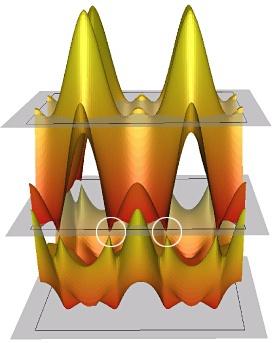

08/29/2011

The Dirac cone is a surface that describes in theoretical terms the unusual electron transport properties of materials like graphene and the even newer class of materials known as topological insulators. Scientists can both predict and measure the existence of a Dirac cone from the relationship between electron energy and momentum, and through such studies have confirmed that the class of iron-based superconductor compounds known as pnictides have this characteristic energy structure. Katsumi Tanigaki and colleagues from the WPI-AIMR and Tohoku University have now demonstrated the effect that such Dirac cones can have on the electron transport properties of these materials1.
The researchers investigated samples of the pnictide Ba(FeAs)2. There is a fundamental difference between the Dirac cones of the pnictides and graphene, however. “The Dirac-cone state of graphene derives from a single 'π-electron' band, while the Dirac-cone states of Ba(FeAs)2 are made from multiple 'd-electron' bands,” explains Tanigaki. This multi-band origin creates a greater chance for the development of a more versatile Dirac-cone structure (see image), depending on the material. The main observable effect of a Dirac cone is a linear relationship between resistance and applied magnetic field, or magnetoresistance, above a certain ‘crossover field’, below which the relationship is parabolic. These curves can be well explained using existing models as due to the effect of Landau level splitting. Under a magnetic field, the electron energy is split into Landau levels, the lowest of which exhibits linear behavior, similar to the feature described by the Dirac cone. On increasing the magnetic field, the level splitting increases and all of the electrons move to this lowest level, which makes the magnetoresistance effect linear. Importantly, this should occur at magnetic fields easily accessible using existing magnets.
A crucial conclusion that can be drawn from the detailed analysis of the data is that the observed magnetoresistance must be caused by a combination of two Dirac cones, one for electrons and also one for their opposite number, holes — a finding that had not been anticipated.
Tanigaki believes that the results could be important for superconductivity, as engineering the compounds to enhance the contribution of Dirac cones could lead to superconductors that operate at higher temperature.
There could also be practical consequences. “High-mobility field-effective transistors are made using superlattice structures in III-V semiconductors. However, we can hope in the future that high-mobility transistors can also be constructed from compounds with Dirac-cone states,” says Tanigaki. The observed linear magnetoresistance could also lead to highly sensitive magnetic field sensors.
Huynh, K. K., Tanabe, Y. & Tanigaki, K. Both electron and hole Dirac cone states in Ba(FeAs)2 confirmed by magnetoresistance. Physical Review Letters 106, 217004 (2011). | article
This research highlight has been approved by the authors of the original article and all information and data contained within has been provided by said authors.